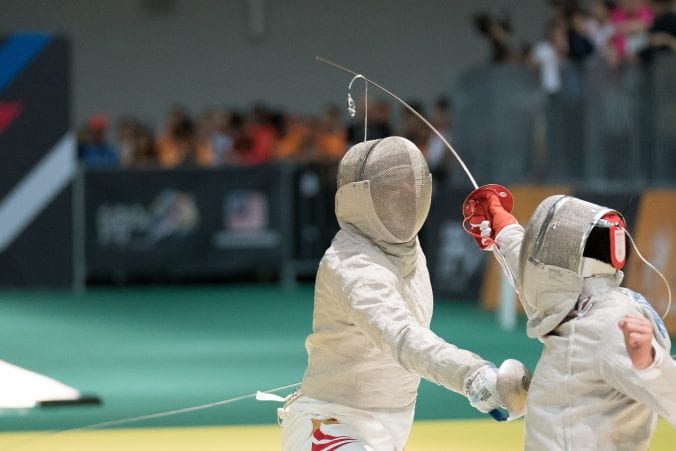Ailsa Harvey
Fencing, one of the first sports to ever appear in the Olympic Games, has three forms in the modern game. These forms include foil, épée and sabre and each uses a different kind of weapon. Competitive fencers usually specialise in one of these weapons, but the foil is generally regarded as the best weapon to begin learning with.
Derived from duelling, fencing originally emerged from the development of sword fighting for self-defence. The sport is played on a strip (2m by 12m long) and the aim is to score ‘hits’ or ‘touches’ on your opponent using one of the three weapons. These touches are recorded electronically by the players body wires because of how fast-paced the action is.
Competitors require quick footwork and reactions in fencing due to the constant change of direction. Fencers focus on their hand movements, lunges and footwork among other skills in their training and timing is said to be essential in earning points successfully.
Although it is one of only five activities which has featured in every modern Olympic Games, cuts to UK Sport’s funding in 2016 has had catastrophic effects for many fencers, leading to many people questioning what is in store for the future of fencing.
Some of Britain’s top fencers, who have had their goals set on the Tokyo 2020 Olympics now face the worry of how they are going to afford to attend such competitions.
British Fencing’s chief executive, Georgina Usher, has said that the team’s chances of qualifying for the Games has been “massively impacted” as they have resorted to a crowdfunding campaign.
UK Sport invests £100m of National Lottery and government money into high-performance sport annually, but none of this is now received by fencers. As a sport trying to gain recognition and inspire potential future champions, this lack of funding is resulting in some athletes being unable to support themselves financially as professionals.
Those at British Fencing believe that in order to improve the predicted future of the sport, wider recognition and accessibility for the sport is vital. An increased interest and participation from men and women, from any age or background can help the sport to grow. Currently, British fencing is receiving donations from the public to keep the sport moving forward rather than backwards.
Did you know…
- Originally, there was no time limit on a fencing bout. This changed when a Masters Championship in New York in the 1930s lasted for seven hours. Now, the time-limit has been set to three minutes for five-touch bouts and nine minutes for fifteen.
- While fencers still wear white today, the original reason for this was to count the number of touches. Before they were counted electronically, ink was used on the weapons and marks made on the white uniforms recorded touches.
- In the Rio 2016 Olympics, British Fencing sent four athletes to the Games, with Richard Kruse placing fourth in the men’s foil.
Have you ever considered trying out fencing? Visit britishfencing.com to find out how you can get involved.
See the video below from British Fencing which focuses on their campaign ‘Give Us The Power’:



Leave a Reply